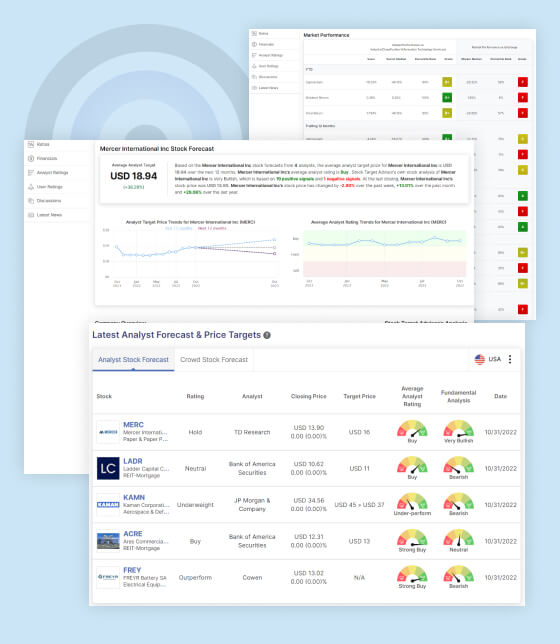AI Market Forecast Analysis
The global stock market appears to be navigating a period of heightened uncertainty, with key economic indicators and political developments influencing investor sentiment. Several factors, including rising U.S. Treasury bond yields, weaker global currencies, mixed economic data, and political turmoil, are likely to impact the direction of stock markets in the short and medium term.
Here’s a breakdown of the key factors identified by Stock Target Advisor’s AI-powered market forecast:
1. Rising Treasury Bond Yields and Inflation Data
The U.S. Treasury bond yields have been climbing, signaling expectations of higher interest rates, likely driven by persistent inflationary pressures. The latest Producer Price Index (PPI) data showing a 3.3% increase year-over-year and 0.2% rise from the previous month confirms that inflation remains a concern, although slightly less than economists had expected. This data supports the possibility of the Federal Reserve maintaining its tightening policy to combat inflation. Rising yields and a more hawkish Fed could put pressure on risk assets, particularly growth stocks, as higher interest rates make future cash flows less valuable and borrowing more expensive.
2. UK and Eurozone Challenges: Economic Slowdown and Political Uncertainty
The UK faces a volatile political landscape with the Labour Party struggling amidst the rise of the Reform Party. This political instability, combined with a weakening pound, exacerbates the country’s economic difficulties. The pound’s depreciation has made imports more expensive, contributing to inflationary pressures. Meanwhile, the German industrial sector, (like Volkswagen AG) is faltering amid its own political uncertainties, including an ongoing election cycle that has dampened business confidence. These challenges in Europe could weigh on global trade, adding downward pressure on European stocks and potentially spilling over into global markets.
3. Canada and U.S. Trade Tensions
In Canada, the GDP per capita has been falling, reflecting slower economic growth amid a rapidly expanding population. Compounding this, the incoming U.S. administration under President Trump plans to implement tariffs as high as 25% on imports from Canada and Mexico. This would increase trade frictions, particularly hurting the North American manufacturing sector and global supply chains. Tariffs could dampen investor sentiment toward North American stocks, especially those reliant on cross-border trade.
4. Oil Price Dynamics: Potential Impact of U.S. Policy
While geopolitical tensions and ongoing supply chain disruptions have kept oil prices elevated, the potential for a U.S. policy shift under President Trump could lead to lower oil prices. With a focus on ramping up domestic oil drilling, the U.S. could potentially increase supply, which could drive prices down. Lower oil prices would generally benefit consumers but could hurt energy stocks and companies reliant on high oil prices for profitability. Additionally, falling oil prices could lower inflationary pressures, which could influence central bank policies globally.
5. Tech Sector Weakness: Semiconductors, and Quantum Stocks
The technology sector, particularly semiconductors, has faced headwinds recently. Nvidia, a leader in AI chips, has seen its stock falter as investor sentiment on the sector has cooled. The broader semiconductor industry, heavily impacted by global supply chain disruptions and weak demand forecasts, is facing challenges. Additionally, the quantum computing space has seen a sharp decline in stock prices, as investors grow increasingly cautious about the long-term viability and commercialization of these technologies. These declines may be a signal that the high-flying tech stocks are undergoing a period of consolidation, with risk aversion mounting in a higher-rate environment.
6. Investor Sentiment and Market Direction
Investor sentiment is being heavily influenced by a mix of economic, political, and corporate developments. The combination of rising bond yields, inflation concerns, and political instability in key regions (such as the UK and Germany) is creating a more risk-averse environment. While some sectors, particularly energy, may benefit from potential policy shifts and falling oil prices, the tech sector is showing signs of vulnerability. The faltering of Nvidia and the broader semiconductor industry is a key concern for technology-focused investors.
Given the rise in yields and the possibility of continued monetary tightening by central banks, markets may face significant pressure in the near term. The overall environment suggests a shift toward value stocks and sectors more insulated from rate hikes, such as energy and commodities. In contrast, growth sectors, especially tech, may continue to underperform as valuations come under scrutiny.
Sectors/Stocks at Risk
Tech and Semiconductor Stocks
Tech stocks, particularly those tied to semiconductor companies and high-growth industries like AI, face the dual pressures of rising interest rates and cooling demand for tech products. As bond yields increase, growth stocks, which are priced based on future earnings, become less attractive to investors, leading to price corrections. The semiconductor sector, which has already experienced volatility, is particularly vulnerable.
- Nvidia (NVDA): As a leader in AI chips and gaming GPUs, Nvidia’s stock has already been under pressure due to weakening demand and competitive threats. Additionally, the broader semiconductor market, which is facing supply chain issues and reduced consumer spending, could further weigh on Nvidia’s stock price.
- Advanced Micro Devices (AMD): Like Nvidia, AMD is heavily reliant on semiconductor sales, especially in consumer and enterprise markets. The cooling tech market and global semiconductor slowdown put AMD at risk of reduced growth prospects.
- Intel (INTC): Intel’s struggle to keep pace with competition from Nvidia and AMD, combined with the broader slowdown in semiconductor demand, may result in further underperformance, especially if the market moves towards more cautious risk appetites.
2. Consumer Discretionary Stocks
Rising interest rates typically have a negative effect on consumer spending, especially for discretionary items such as electronics, automobiles, and luxury goods. As inflation persists and borrowing costs increase, discretionary spending is likely to slow down, impacting these companies.
- Amazon (AMZN): Amazon, as a leading e-commerce giant, is sensitive to consumer spending patterns. As interest rates rise, consumers are likely to pull back on non-essential purchases, which could affect Amazon’s top line. The company also faces pressures from rising logistics and labor costs.
- Tesla (TSLA): Tesla, though an electric vehicle leader, remains at risk as rising rates increase borrowing costs for consumers looking to finance new cars. Higher interest rates could dampen demand for electric vehicles, especially in a market facing slowing economic growth.
- Home Depot (HD) & Lowe’s (LOW): These home improvement giants may be affected as rising mortgage rates slow down the housing market. Homeowners may delay renovations or home purchases, impacting sales growth for these retailers.
3. Financials
While rising interest rates could initially benefit some financial stocks by widening the spread between short-term and long-term borrowing costs, financials are also exposed to potential credit losses if the economy slows or if inflation pressures squeeze consumers and businesses.
- JPMorgan Chase (JPM): As a leading U.S. bank, JPMorgan is vulnerable to economic slowdowns that could lead to higher credit defaults, particularly in consumer and small business lending. Rising rates also reduce demand for mortgages, which can hurt revenue streams.
- Bank of America (BAC): Similarly, Bank of America could see a hit to its earnings if the broader economy slows and loan growth stalls due to higher interest rates.
- Wells Fargo (WFC): Wells Fargo faces the dual risk of economic slowdown and tightening regulations. The bank’s reliance on lending makes it sensitive to interest rate changes and credit risks in a volatile market.
4. Energy Stocks (Oil and Gas)
While lower oil prices could provide some relief to consumers, energy stocks face risk from geopolitical developments and potential policy changes. The possibility of increased drilling and production in the U.S. under the new administration could lead to overproduction, potentially driving oil prices lower.
- ExxonMobil (XOM) & Chevron (CVX): These energy giants could face pressure if oil prices decline due to an increase in domestic production in the U.S. or if global demand weakens amid economic slowdown. Additionally, rising regulatory scrutiny on the oil and gas industry could present risks to long-term profitability.
- Occidental Petroleum (OXY): With a focus on shale oil, Occidental Petroleum is particularly vulnerable to price fluctuations in crude oil. Lower oil prices or reduced demand for oil could directly impact earnings and stock performance.
5. Industrial Stocks
Industrial stocks are highly sensitive to geopolitical issues, especially trade tensions. The potential implementation of tariffs on Canada and Mexico under the incoming U.S. administration, combined with ongoing political turmoil in Europe and the U.S., creates significant risk for companies heavily reliant on international trade and manufacturing.
- Caterpillar (CAT): As a major player in heavy machinery and construction, Caterpillar is vulnerable to reduced demand for construction and infrastructure projects, particularly in regions where trade tariffs and political instability are increasing. A slowdown in global manufacturing also poses risks to its operations.
- Deere & Co. (DE): Similar to Caterpillar, Deere’s agricultural machinery business is tied to global agricultural trends, and tariff impositions could lead to supply chain disruptions or reduced demand in key markets.
6. Chinese Stocks
Chinese companies are particularly vulnerable due to the ongoing geopolitical tensions with the U.S. and regulatory pressures at home. Rising interest rates in the U.S. and economic uncertainty in China further threaten their growth prospects.
- Alibaba (BABA): Alibaba, as China’s leading e-commerce company, is facing increased competition, regulatory scrutiny from the Chinese government, and a slowdown in domestic consumer spending. Additionally, global trade tensions and U.S. tariffs could further hinder its performance.
- JD.com (JD): Like Alibaba, JD.com faces the challenges of China’s slowing economy and its dependence on international trade. The potential for further regulatory crackdowns on tech companies in China also creates uncertainty for JD’s growth.
7. Quantum Computing Stocks
Quantum computing stocks are highly speculative, and many have seen significant losses as market sentiment shifts toward caution. The technology is still in its early stages, and the commercial viability remains uncertain, making these stocks highly vulnerable to market corrections.
- IonQ (IONQ): As one of the leading quantum computing firms, IonQ is under significant pressure from market volatility and skepticism regarding the technology’s long-term commercialization. The company’s heavy reliance on investor capital further puts it at risk if the market becomes more risk-averse.
- D-Wave Systems: D-Wave, another quantum computing company, faces similar risks due to the uncertain outlook for quantum technology. As interest in speculative tech stocks wanes, D-Wave’s stock could continue to underperform.
Outlook
The stock market is likely to experience increased volatility over the coming months as investors react to a complex set of factors: inflation concerns, rising interest rates, geopolitical tensions, and political instability. While there may be opportunities in sectors such as energy and commodities, the tech sector appears more vulnerable, with specific challenges for semiconductor and quantum stocks. Political risks, particularly in the U.S., UK, and Canada, could further weigh on market sentiment, and trade tensions may exacerbate global economic challenges.
As some central banks continue to fluctuate in their policy stance, the overall market direction may be skewed toward caution, with a potential shift from growth to more defensive sectors. Investors should remain vigilant, focusing on stocks that are well-positioned to weather these economic and political storms.

STA Research (StockTargetAdvisor.com) is a independent Investment Research company that specializes in stock forecasting and analysis with integrated AI, based on our platform stocktargetadvisor.com, EST 2007.

















































